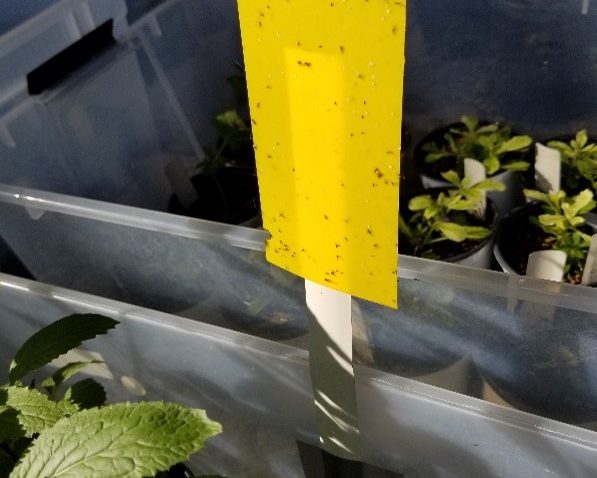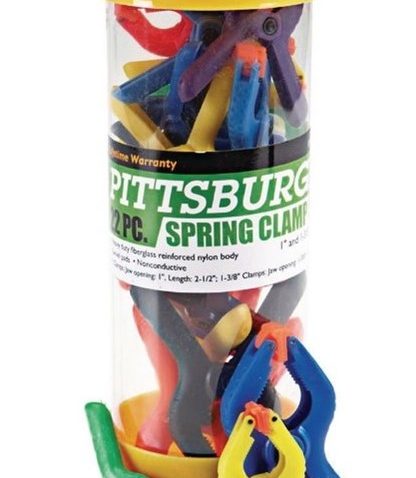
by Stan Logan | Mar 16, 2021 | Propagation
Years ago I bought a pack of 60 sheets of yellow sticky traps figuring that it was enough to last a life time. I now see that the stack of sheets is running low. I’m afraid that does not bode well for my future. But until we both expire, I’ll keep plodding along.
The reason for my original purchase was to do battle with the white flies that like to infest our iris beds. Being cheap, I always cut the letter size sheets vertically into thirds and then hung these narrow strips throughout the beds every year. That technique has worked fairly well as whenever we walk through the beds, we purposely knock against the plants, the white flies fly up and zip over to the yellow strips to which they become stuck.
When LaVille mentioned that several of the plants she was propagating started to get white fly, I cut sheets into thirds and then those strips in half. I then mounted them on miniblind stakes and taped the stakes to the sides of the totes in which the plants were being raised. Well this was only partially successful as the stakes stuck to the totes, but the mini pieces of sticky sheet sometimes did not want to adhere to the stakes. The yellow sticky sheet material is flat and likes to stay that way—they didn’t want to bend around the bent stakes. Adding blue masking tape worked somewhat, but I found small metal clips worked as a last resort.
So far, pretty boring, right? Well, look at the accompanying photo. See the attached white flies? . . . No, you can’t. They are tiny, and blend right in with the yellow mini sheet. I just took a flashlight (It’s night time) and tried to count the white flies. I figure there is at least 100 on both sides of the yellow mini sheet. Look at the photo. Guess what those dark specks are? Those are fungus gnats. It’s a 2fer! After the sticky mini strips were in place for about 4 days, no flies or gnats appeared when we brushed the plants. Adults were eliminated, so the life cycle was broken.
So if you have any trouble with white flies or fungus gnats, try using these yellow sticky traps. I have to tell you though, working with these is a real pain. I mean these traps are really sticky. You can remove sticky stuff from you fingers with paint thinner.
Well, I feel foolish. I just checked Amazon and found that there are all kinds of small yellow sticky traps now available. Not only that—they actually advertise use on fungus gnats and flying aphids as well as white flies. Do I feel out of touch!
Stan, The Feeling Old Man

Capture gnats with sticky trap

by Stan Logan | Mar 3, 2021 | Garden tools, Weeds
Once again it is beneficial to look outside the box. Here we have a versatile item that you won’t find in your local nursery. Please note that although labeled “Spring” clamps, these devices may be used during all 4 seasons—and especially in the Summer. You can see by the accompanying photo, that they are brightly colored, which will hopefully prevent their loss. (I haven’t seen your garden, but I suspect you may have the tendency to leave stuff all over.) This complete variety of color allows you to accessorize your gardening attire with clamps that will attach anywhere. I don’t have much capability, but I suppose you could even adorn your hair with these snazzy items. I tried this idea, but found it rather painful.
So how would you use these clamps in the garden? You could support plants. You wouldn’t pinch the plant itself—that would be cruel—but enclose the branch and clamp to a supportive structure. Using this on vines, tomato plants, and bougainvillea immediately comes to mind, but, really, any plant that requires staking would be a good candidate. Then there’s the need to attach sheet material—bird netting, shade cloth, frost protection, tarps. Could you use it to attach labels? How about hanging yellow sticky sheets. Maybe you need to close a bag of fertilizer. How ‘bout sticking one on your body to remind you to turn off the water.
I think you can see that there is almost no end to the uses for this versatile tool. You are probably not trying to decide whether or not to buy, but how many to buy. Well, the good news is that these clamps are really cheap. You can purchase a set of 22 clips for only $4.99 at your closest Harbor Freight, so don’t hold back!
Happy Clamping,
Stan, The Tool Man
P.S. If you really want to travel outside the box, google “clampers.” My brother-in-law is one of these.

Spring Clamps
by Stan Logan | Jan 20, 2021 | Weeds
What are your thoughts when you hack at a weed with a hoe? How about when you plunge a weeder into the soil and penetrate the tape root of a plant you don’t appreciate. Have you ever paused when you were about to grab a plant by the neck and yank it out of the soil it depends on for life? When you use a propane torch to cook and then scorch a solitary weed and hear the popping of the seeds that would otherwise provide future generations of that plant, how are you feeling? Have you ever stopped to think that these plants that you so fervently pursue and torture with Roundup are simply trying to survive—to survive and continue the lifeline of their existence?
I ask you, “Where’s the empathy?” . . . Not here . . . But sometimes . . . . . . .
by Stan Logan | Jan 19, 2021 | Weeds
Generally it is a pleasant experience being on a gardening team. I know Daisy would back me up on this concept. But there are times when disagreements can arise—specifically, what plants need to be eradicated, and which are left to survive—what’s a weed and what’s not. You have heard the saying that it is easier to ask for forgiveness than to ask for permission. I have found that this axiom doesn’t work well when weeding in the garden. You see, once a plant is extracted, survival upon replacement is seldom successful. I have found that saying “You should have been watching what I was doing!” does not go over well. Or “It looked like a weed to me” doesn’t fare well either. I have found that frequent asking of permission has proven to the least painful option when weeding. I’m just sayin’.
Stan
by Stan Logan | Jan 18, 2021 | Garage and estate sales, Garden tools
I don’t know if you remember, but several times I have emphasized the importance buying tools that are as light as possible—as long as it doesn’t affect the quality or effectiveness of the tool. This would apply particularly to shovels and brooms. This fact was brought to mind when I recently received a birthday gift from one of my sons. This shovel arrived in a box from Lowes that was so mangled and mashed, that you wouldn’t think anything inside could have survived, but survived it did. Now, this 48 inch Cobalt steel digging shovel is really substantial—no wonder it survived. The handle is steel and the step flange is wide which is advertised to not hurt your foot (like I’m going to be out digging barefoot or in flipflops—come on!). Anyway, the point is that this shovel is heavy. Every time I heft the shovel, I am lifting the weight of the shovel as well as its load—wasted energy. This shovel is so substantial that it comes with a lifetime warrantee. If I didn’t know this son better, I would suspect that he has sights on this tool in the end, if you know what I mean. In the meantime, the shovel is awaiting a significant sharpening as the shovel blade is really thick.
Boy! When I digress, I don’t go halfway. I am trying the make the point that several tools are better when they are light. This is particularly true with leaf rakes, which you use by constantly swinging them back and forth. I am in love (not really) with a rake I found at a garage sale. It is the Blue Hawk 24 inch leaf rake. The Blue Hawk series of products are entry level tools from Lowes. The handle is made of light wood. The rake head is light plastic, and only the tines are metal. I found by accident that you can actually improve this rake. One day I was too lazy to pick up the rake from the lawn and thought I could pass over it without harm. The mower ripped off 4 of the tines on one side. (I never did find the tines.) I used this lopsided rake for many months until I came up with the idea of removing 4 tines from the other side by sawing through the plastic head. Now, through serendipity (stupidity) I have a long handled, narrow headed rake with long tines that is able to remove leaves from tight confines. Since then, I was able to buy another Blue Hawk at another garage sale, so I have a full-size rake as well. So, my suggestion to you is that, if you need a rake, go to Lowes and pick up one of these light-weight beauties for about $10. Then, if you want to improve your raking capability, buy a second one and cut off tines from each side. You can skip the mower part.
Happy raking! Stan The Tool Man



